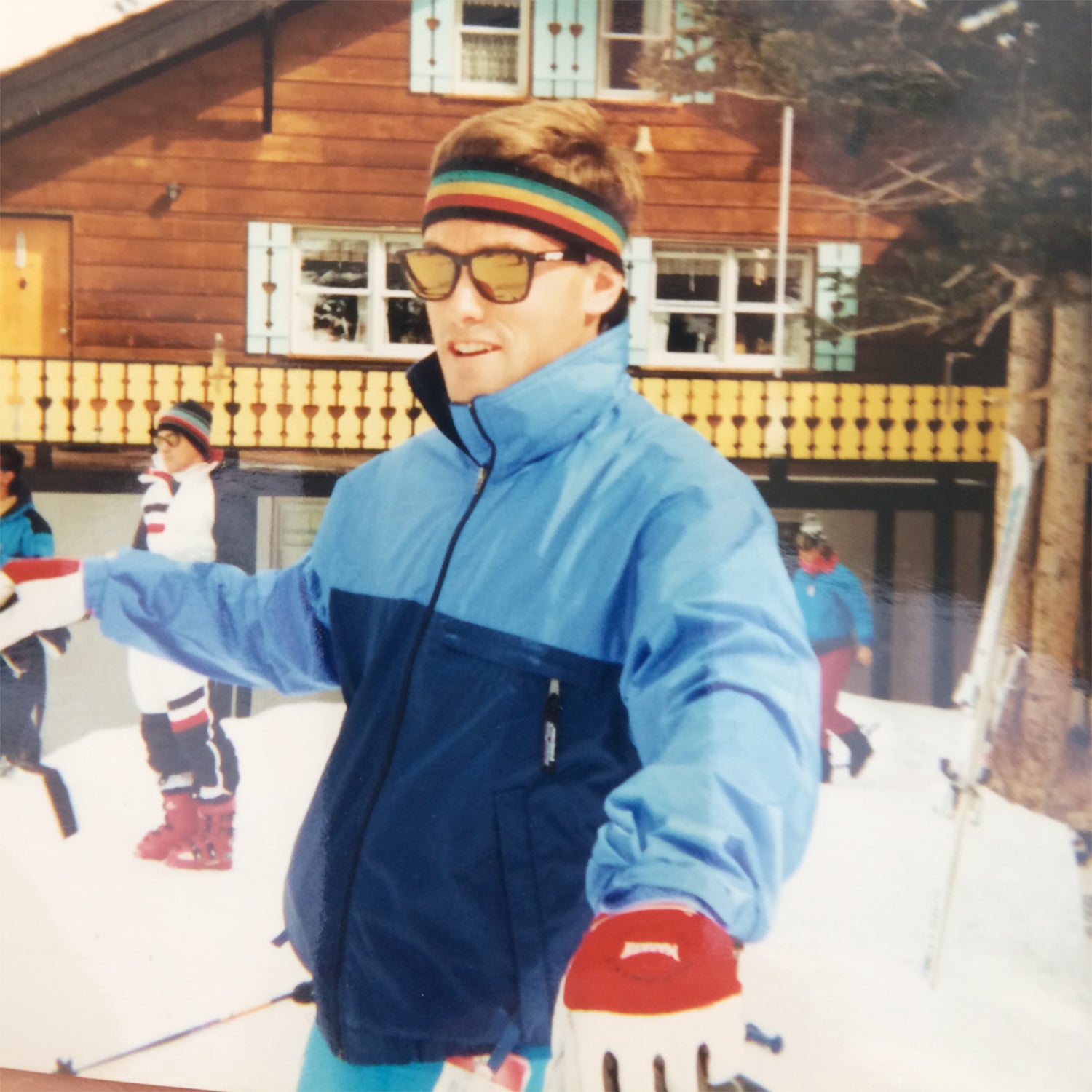Fresh out of Massachusetts, the 20-year-old me was wicked dumb. Hey, science tells me that my brain wasn’t fully developed at that age—and as soon as it was fully developed, science tells me that it began to decay. You really can’t win. Anyway, thrilled to be in the mountains of New Hampshire and Colorado, I threw myself into the outdoor world with no training, few mentors, and a damn-the-torpedoes worldview that predictably ended up with many torpedoes coming my way. My youth is a lost cause at this point, but maybe you can glean a few tips from my hard-earned lessons.
Wear the Goggles
I actually got this warning from a ripping 50-year-old Copper Mountain ski instructor during my first (and only) year instructing. “The sun at altitude will give you cataracts,” she told me on day one. “Keep your goggles on until you go inside.” I’ve heeded that advice while resort skiing, but in the backcountry, I switched to sunglasses for the uptrack on account of overheating and fogging. Not a great idea. A ski photographer friend whose job requires standing in the sun while wearing low-profile RX sunnies just got out of cataract surgery last week. Be more selective about the shades you wear. I started touring in the original POC Do about eight years ago because it offers almost as much coverage as glacier glasses. The updated comes close.
Ditch the Chemicals
Back in the day, we would douche our apparel in Scotchgard, a toxic waterproofer made by 3M full of known carcinogens. Great. Most of the waterproof-breathable gear we buy is still coated with the same perfluorocarbons (PFCs) found in the old Scotchgard spray cans. Until the industry is forced to clean up its act, you can limit your exposure and help the planet by washing and treating your ski pants in Nikwax-brand cleansers and waterproofers, which contain no toxic chemicals.
Your Core Runs from Hips to Shoulders
My back was thrashed in my late twenties and early thirties. At the time, I had no idea what core training really meant, so I would supplement stupid weightlifting exercises (never use a weight machine) with old-school sit-ups. My abs were strong, but my lower back was as weak as a kitten’s, creating an imbalance that led to a bad compression while mogul skiing. That injury, in turn, led to a bulging disk, which led to chronic inflammation and pain. Now in winter, I skate ski and reinforce my lower back with , further bolster my core with exercises similar to the ones performed by the greatest , and weight train in a more subdued way (like Olympic gold medalist ).
Beware the Wax
It’s cool to tune your own skis, but the high-end fluorocarbon waxes Nordic and alpine racers covet also pose grave health risks. Two studies in Norway and Sweden have found that those fluorocarbons, a likely carcinogen, of wax technicians. The fix? Stop buying the spendy fluorocarbon waxes unless you’re on the World Cup, and opt for a friendlier alternative, like Purl Wax (if you’re a dedicated hot waxer) or DPS’s new Phantom 2.0 non-wax that lasts the life of the ski (if you’re a freeskier or ski tourer). Also, don a quality respirator and wear the safety glasses. My pal who works for Rossignol can’t see much out of one eye after a piece of metal he was machining sent shrapnel into it.
Stand Up Straight
About 15 years ago, I was ripping around Snowbird with a great skier. We came past a rocky outcropping into a steep chute and encountered a woman gripped by the exposure. Standing sideways to the fall line, she was leaning back into the hill as if there was some safety to be found there. My friend told her to stand up straight. She did. And in doing so, her edges made better contact with the steep terrain. Now balanced over her feet, she was able to swing the skis around into that next ski turn. Unless you’re , you do fundamentally the same thing when you’re traversing a slope on crampons or riding a bike near the edge of a precipice. To lean into the earth is human nature. To stand up in the void is more of an avian act. That type of transcendence takes courage. It’s also a skill that you can practice.
Watch What You Eat
It sounds like a Jenny Craig tweet. It’s not. I started paying attention ten years ago when a doctor buddy I ski and bike with convinced me that I should eat like my Mediterranean ancestors. The arguments he made in his were convincing enough from a long-term health perspective. Who wants Alzheimer’s and heart disease? But I’m a short-term-goal person, so I still wasn’t eating right most the time. It wasn’t until I read some from (of all people) “nutritionist to the stars” Philip Goglia that I stumbled on a diet that worked for me as a recreational athlete. While Goglia pointed out that athletes really can’t eat too many vegetables (the basis of the Med diet), he also said that athletes shouldn’t eat inflammatory dairy, gluten, mold, or yeast-based products. Merging the approaches, I ended up with a table rich in fresh green leafy vegetables, plant-based fats, lean proteins, and whole (unprocessed) carbohydrates. I now feel as though I’m better fueled for hard efforts on the bike, and I recover better. And since I cut Goglia’s four, I’ve had neither seasonal allergies nor a single asthmatic episode (I’ve been asthmatic since childhood). Maybe that will work for you, maybe it won’t. But, hey, I’m not a doctor—and this is a letter to me.
Protect the Knees
Cyclists know that cold air and exposed knees can lead to tendon damage. The maxim? Below 65 degrees, wear knee warmers; below 55 degrees, wear leg warmers; below 35 degrees, wear your thickest insulated bibs. (Or, if you’re a mountain biker, these more casual pants.) It was pro big-mountain skier Chris Davenport, though, who turned me on to knee pads for skiers. I started wearing them when I was bootpacking up couloirs in spring or scrambling up rock in the backcountry, but I grew accustomed to the crash protection and added warmth they offered inbounds as well. Now I ski with all winter long.
Don’t Submit in Advance
Explore all the ways you can to avoid the knife. Before undergoing surgery for a heart arrhythmia called supraventricular tachycardia, I told my cardiac electrophysiologist that I was a heavy caffeine user. He scoffed at the connection. It was only after the failed procedure (and $15,000) that I stumbled upon a study that said researchers have triggered tachycardia in rats with caffeine. I quit caffeine and haven’t had an episode since. My shoulder used to dislocate all the time when I was young, but the right exercise (skate skiing again) and learning how to crash healed it. Ditto with my aforementioned back that a surgeon wanted to cut into when I was in my twenties. We have amazing health care in this country, but don’t just blindly submit to the system. See a physical therapist first.
Get Forward
This is different advice than stand up straight. When you’re skiing or mountain biking steep terrain, don’t shift your weight back. Before fat skis and slacker long-travel forks, we used to have to do exactly that (just a touch) in powder and on steep singletrack, and those are tough habits to break. On skis, stay centered and let the ski float you as you drive turns from your core. For a reference, check out Sam Cohen’s upper-body position in this edit . Zero wasted energy. On a mountain bike, use the dropper post to pull yourself down and forward to weight the front tire, balance your weight in the suspension, and actively pilot the bike instead of using it as a sled. I’m still learning that last bit.
Go the !@#$ to Sleep
Tom Brady espouses that sleep is as vital to performance as skills, nutrition, and cross-training. He’s , but you don’t need his fancy . Sleep was always an afterthought when I was younger. I slept poorly, which means I performed poorly and recovered poorly. Now I think about sleep, which means I think about stress. This past summer, cycling great George Hincapie told fellow doper Lance Armstrong on their podcast that he tried to compartmentalize stress—addressing what he could during the day and putting the rest in a box before bed. I’ve found that pretty helpful. I now give myself nine hours in bed with the hopes of hitting eight hours of sleep—which is probably my magic number, according to this compilation story from the .
Gear Matters: A Tale of Entropy
I knew the lightweight Schwalbe tires weren’t a match for the rocky Breck Epic course, but unable to find the in town, I figured I’d wing it. What happens next is a cautionary tale. As expected, I tear a sidewall on a bombing descent. No problem. I got this, I think. I’m quick with tire repairs. So I slap a boot on the tear, but in my hurry to inflate, I snap the valve stem off the tube. No problem. I have a second tube in my saddlebag. As I extract that tube, though, the stitching on the saddlebag rips. As I prepare to rejoin the race, I now have a spent tube and a worthless saddlebag in my hands, so I shove them into my overcrowded jersey pockets, telling myself I’ll clean up my act at the next aid station. Except I never make it. As I get up to speed on a smooth descent, the tube works its way from my jersey and into my spokes. What follows is the most sudden and violent bike crash I’ve ever experienced. I end up staggering to the road with a shattered clavicle for an ambulance ride to the ER. The conclusion: Gear matters. As a guide on Mount Rainier once told our group of ���ϳԹ��� editors, “Get your shit dialed.”


